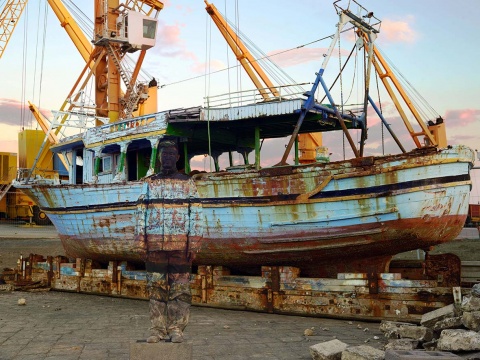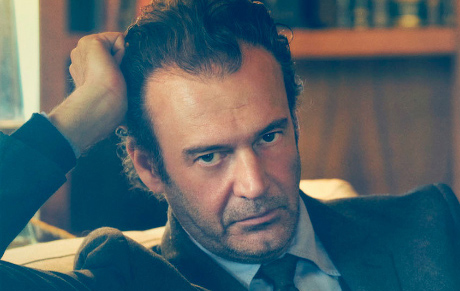LIU BOLIN – L’ARTE DEL MIMETIZZARSI
Liu Bolin è un artista cinese che crea opere molto interessanti combinando Arte, fotografia e protesta. Nelle sue performance di mimetismo, l’artista si fa ricoprire di vernice per dissolversi perfettamente nello sfondo delle ambientazioni delle sue fotografie. Per creare queste opere l’artista spesso sceglie luoghi in qualche maniera collegati con i simboli della Rivoluzione Culturale cinese, o che evocano gli immensi cambiamenti avvenuti nel paese dopo la caduta del regime di Mao Zedong.
Il team di Kooness.com ha intervistato Liu Bolin a proposito del suo ultimo lavoro “Migrants”, dove l’artista pone l’attenzione sul’attuale situazione dei flussi migratori e sui rifugiati.
Nonostante la giovane età hai un grande percorso artistico alle spalle, ci racconteresti le varie fasi della tua attività di artista e come sei approdato all’ultimo lavoro sui migranti? Ho cominciato a realizzare le opere fotografiche, confluite poi in nella serie “Hiding in the City” nel 2005. Fin dall’inizio ho previsto che il mio corpo venisse colorato con gli stessi toni e sfondi dell’ambiente circostante, in modo che, da una certa angolazione, scomparisse nel panorama alle mie spalle. L’impulso primigenio è stato la ribellione nei confronti delle autorità, che stavano demolendo il mio studio. E’ nato così il primo nucleo di quella che sarebbe divenuta una serie. La rabbia che provavo mi ha spinto a mimetizzarmi tra le macerie del villaggio e a diventarne parte. Nel silenzio credo di essere riuscito a dire molto di più che con azioni rumorose. Da quell’evento tragico sono iniziate le serie dei miei lavori in cui mi nascondo nelle città. Poco dopo mi sono deciso a proseguire in quella ricerca, che descriveva la mia vita, il mio destino, ma aveva anche tanti punti in comune con la vita degli altri. Constatavo tra la gente che molti dei dubbi e degli interrogativi che mi ponevo io, erano condivisi da tutto il popolo cinese. E non solo. Successivamente, quando ho avuto l’opportunità di viaggiare all’estero per i miei progetti, mi è capitato di visitare tra i primi luoghi l’Italia, dove ho ritrovato, sorprendentemente, nella quotidianità di questo paese, le medesime incertezze e disarmonie. Attraverso le mie opere io cerco perciò di sviscerare queste contraddizioni dell’uomo contemporaneo, e di indagare nel profondo il rapporto tra la civiltà creata dall’uomo e l’uomo stesso. Il progetto dal titolo “Hiding in Italy” nasce dunque come declinazione italiana della più ampia serie di scatti di performance “Hiding in the city”. Il mio recente lavoro “Migrants”, sempre in collaborazione con Boxart, la galleria italiana che mi rappresenta, ha come obiettivo una riflessione sui flussi migratori. Non è un tema facile, esprime il costante bisogno umano di migliorare la propria condizione.
Le tue opere sono il risultato di un lungo processo di ricerca e organizzazione, ci potresti descrivere il lavoro che c’è dietro i tuoi scatti e quante persone sono coinvolte? Ho fatto diversi sopralluoghi tra Lampedusa e Catania. Poi, attraverso il valido aiuto della Comunità di Sant’Egidio di Catania siamo riusciti a coinvolgere decine di giovani migranti dal C.A.R.A. di Mineo e da altre strutture di Bronte e Giarre. Tutti provengono dall’Africa, da paesi diversi: Nigeria, Senegal, Burkina Faso e altri. Grazie a questa collaborazione ho deciso di ospitare più persone nello scatto: quattro opere sulle sei eseguite appartengono dunque all’evoluzione del mio lavoro, ovvero alla serie “Target” (“Bersaglio”), in cui scompaiono più figure nello sfondo. Ho iniziato “Target” tre anni fa con l’opera “Cancer Village”, per denunciare che lo sviluppo economico in Cina ha come risvolto negativo l’insorgenza di gravi malattie, a causa di un ambiente nocivo per i cittadini. Stavolta, in Sicilia, ho voluto affrontare i problemi dei migranti africani. Le tensioni politiche hanno provocato dei flussi migratori tra Africa ed Europa e il conseguente fenomeno dei rifugiati. Questo argomento a me interessa molto, è una vera tragedia umanitaria. Attraverso lo sfondo dei miei lavori in Sicilia, in particolare i barconi al Porto di Catania, voglio sensibilizzare maggiormente la gente su questo problema.
Negli ultimi anni il fenomeno dell’online è entrato a fare parte di molti settori, ultimamente anche il mondo dell’arte contemporanea sta vedendo nascere molti fenomeni volti alla diffusione e promozione di questo mondo, cosa ne pensi? Io stesso sto lavorando ad una nuova serie che si intitola “Hacker” in cui sostituisco sui siti governativi le foto di luoghi-simbolo del potere con le medesime immagini, in cui però all’interno sono nascosto io. La mia vuole essere una riflessione sulla comunicazione contemporanea; nell’era di una intensa virtualizzazione, voglio esplorare ciò che rimane reale. Infatti, in questa serie non sono più l’uomo invisibile, ma tengo in mano una lampadina, simbolo dell’ingegno e del pensiero umano. Siamo all’inizio di una nuova era, l’Età del network. Io cerco di essere un artista-informatore che cerca si aumentare la consapevolezza delle persone circa il potere delle immagini. C’è sempre un significato più profondo di un’immagine, che mette in discussione l’anima umana e lo spirito. In questa nuova serie sfido il potere delle immagini cambiando quelle originali. E’ un tentativo di iniziare una guerra contro le immagini.
Scopri le opere di Liu Bolin presso la Galleria Boxart qui
LIU BOLIN – THE ART OF CAMOUFLAGE
Liu Bolin is a Chinese artist that creates compelling works combining Performance Art, photography, and protest. In his Camouflage Performance works, Liu covers himself in paint to immaculately fade into the backdrop of a photographed scene. To create his works, Liu often chooses sites replete with symbols of China’s Cultural Revolution, or suggestive of the immense changes in the country since the fall of Mao Zedong’s regime. We have interviewed the artist about his latest work “Migrants”, where the artist focused the migrant flows and the resulting phenomenon of refugees. Despite your young age you have a great artistic career behind you. Can you tell us the different stages of your artist career and how did you arrive to the last work on migrants? I started to realize the photographic works, then merged in the series “Hiding in the City” in 2005. From the beginning I expected that my body was colored with the same tones of the surrounding environment, so that, by a precise angle, I disappear in the landscape behind me. The first impulse was rebellion against the authorities, who were demolishing my studio. In this way born the first nucleus of what would become a series. The anger I felt inside inspired me to blend among the ruins of the village and become part of it. In silence I think I’m able to say more than with many noisy actions. From that tragic event began the series of my work where I hide in the cities. Shortly after that I decided to continue the research, which described my life and my destiny, but also had many points in common with the lives of others. I observed that many of the doubts and the questions that I was asking myself, were shared by the Chinese people. Later, when I had the chance to travel abroad thanks to my projects, one of the first places I visited was Italy, where I found, surprisingly, in the everyday life of this country, the same uncertainties and disharmonies. Through my work I try to unravel these contradictions of contemporary man and to investigate in depth relationship between the civilizations created by man and the man himself. The project “Hiding in Italy” was born as a variation of the Italian shots of the wider serie “Hiding in the city”. My recent work “Migrants”, in collaboration with Boxart, the Italian gallery that represents me, has as goal a reflection on migration. It is not an easy subject that expresses the constant human need to improve their condition. Your works are the result of a long process of research and organization, could you describe the work behind your shots and how many people are involved? I visited several times the area between Lampedusa and Catania. Then, through the valuable help of the Community of Sant’Egidio of Catania we were able to involve dozens of young migrants from C.A.R.A. of Mineo and from other structures of Bronte and Giarre. They all come from Africa, from different countries: Nigeria, Senegal, Burkina Faso and others. Through this collaboration I decided to accommodate more people in the shot: four works over six belong therefore to the evolution of my work, the series “Target”, in which several figures disappear into the background. I started with “Target” three years ago with the work “Cancer Village”, to denounce that economic development in China has created serious health diseases due to a harmful environment for citizens. This time, in Sicily, I wanted to address the problems of African migrants. Political tensions have caused migration flows between Africa and Europe and the resulting phenomenon of refugees. I really care about this, because it is a real humanitarian tragedy. With my works in Sicily, in particular the barges at the Port of Catania, I want to raise people awarness about this issue. In the last years many sectors have been involved in the online revolution, recently even the contemporary art world, which is your opinion? I am working on a new series titled “Hacker” in which I replace the government websites photos of symbolic places of power with the same images, but where I’m hiding inside. My art is a reflection on contemporary communication; in the era of intensive virtualization, I want to explore what remains real. In fact, in this series I am no longer the invisible man, but I hold a light bulb, the symbol of intelligence and of human thought. We are at the beginning of a new era, the age of the network. I try to be an artist-informant who is trying to raise awareness of people about the power of images. There is always a deeper meaning of an image, which calls into question the human soul and spirit. In this new series I challenge the power of images by changing the original. It’s an attempt to start a war against the images. Discover Liu Bolin artworks on Boxart Gallery here






